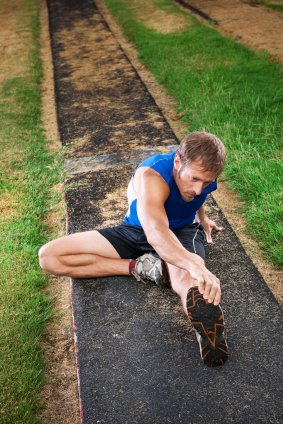
Why is the running community so divided on this topic? Your junior high gym teacher probably required you to do a series of stretches at the beginning of each class. These exercises might have included toe touches and hamstring stretches. Proper form was usually neglected.
But did these exercises actually warm up your muscles and joints? Well, science now suggests that your whistle-blowing phys-ed instructor was ill-advised. Back in 2008, the New York Times reported that “researchers now believe that some of the more entrenched elements of many athletes’ warm-up regimens are not only a waste of time but actually bad for you. The old presumption that holding a stretch for 20 to 30 seconds—known as static stretching—primes muscles for a workout is dead wrong. It actually weakens them.”
So runners, take heed. Don’t stretch before running. You can risk injury.
“There is a neuromuscular inhibitory response to static stretching,” Malachy McHugh, the director of research at the Nicholas Institute of Sports Medicine and Athletic Trauma at Lenox Hill Hospital in New York City, told the Times. “The straining muscle becomes less responsive and stays weakened for up to 30 minutes after stretching, which is not how an athlete wants to begin a workout.”
Jeff Galloway, who is cited in the new book, Return to Fitness, by Bill Katovsky, takes an anti-stretching view; his opinion in all matters of running, is worth listening to: In one of his running books, he writes, ““Stretching is the third leading cause of injury among runners. You can injure yourself while doing a stretch that seems perfectly safe.” Ouch! “Stretching does not warm you up for a run,” he continues.“The best warm-up for running is walking or very slow jogging.”
“The right way to warm-up should do two things: loosen muscles and tendons to increase the range of motion of various joints, and literally warm up the body,” Duane Knudson, professor of kinesiology at California State University, Chico, also told the Times. “When you’re at rest, there’s less blood flow to muscles and tendons, and they stiffen. You need to make tissues and tendons compliant before beginning exercise.”

Most of the research and information i have read, that seems to point to stretching before running causing injuries, has more to do with how the stretches are performed than it does with stretching actually causing injuries. Most stretches and stretching routines violate biomechanical and physiological laws of the human body. Stretches done in a more friendly manner to the body can help prepare the body for any activity, including running. Probably the best example of stretching that works with the physiological laws of the body has been pioneered by Aaron Mattes, it is Active Isolated Stretching (AIS).
There are two primary principles that provide the basis for how AIS works. The first is called reciprocal inhibition. An example of reciprocal inhibition is when you want to lift your arm, your nervous system must shut off the opposing muscles that keep your arm down. By utilizing reciprocal inhibition, AIS involves your nervous system in the stretch, making it easier for the muscle being stretched to elongate.
The second principle is the 1.5 to 2 second stretch. Holding a stretch for longer than this causes the body to engage a protective reflex, causing muscle contraction in the muscles you are trying to stretch. his protective reflex results in the “stretch” sensation often felt during a prolonged stretch and is actually the muscle entering into a tug of war with itself. The muscle is trying to contract as you are trying to lengthen it. This tug of war results in less blood flow to the tissue.
By not tripping the stretch reflex, the muscle receives a gentle stretch without the body fighting itself. The stretch is then repeated 8 to 10 times. The repeated pumping action of the muscle allows for increased circulation to the area. Because the stretches target highly specific areas of the body and work with the physiological laws of the body, AIS provides a more efficient and effective stretch that allows the client faster relief and better results.
You can check out AIS at… http://www.brookseminars.com/ais or http://www.stretchingusa.com/aboutAIS.cfm
Most common stretching necessitates a hold of anywhere from 10-30 secs. This will cause an eccentric lengthening, ultimately releasing protein bound ions which will cause capilaries to relax, decreasing blood flow and reducing O2. I agree with Sarah’s comments above, AIS Is a sensible effective way to prepare the myofascia with increased blood flow, nutrients, and piezoelectric current communication, and greatly enhanced lymph movement!
http://www.stretchingusa.com ….. Brookseminars.com/ais
About stretching after a run?